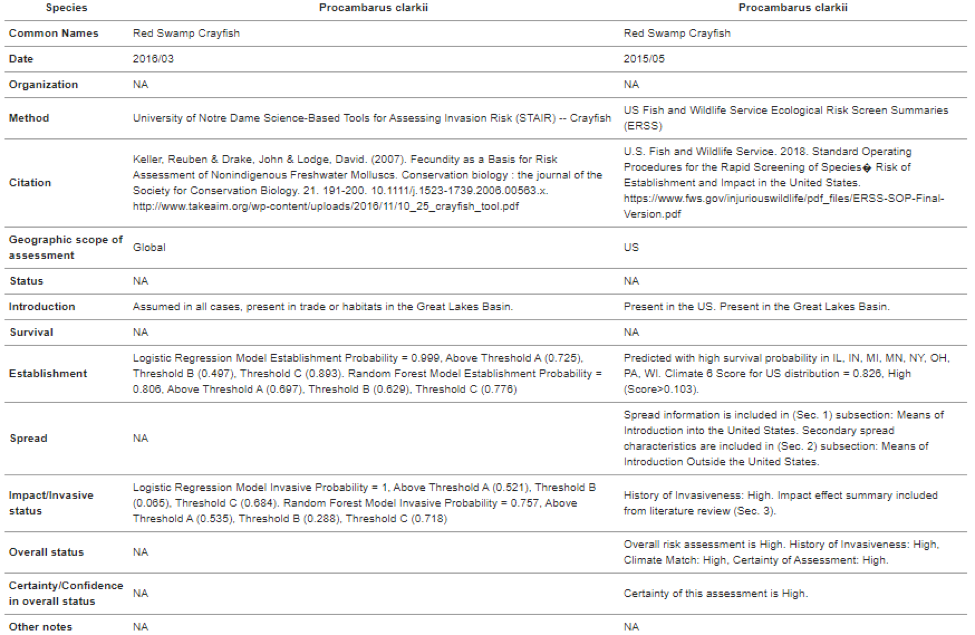GLANSIS risk explorer evaluates the potential for Great Lakes biological invasions
The Risk Assessment Clearinghouse makes it easier for scientists and environmental managers to compare and contrast cutting-edge risk information to inform their own decisions.

With 188 aquatic nonindigenous species currently established in the Great Lakes region, more than 80 on the regional watchlist, and dozens more posing potential invasion threats in the future, evaluating the risks generated by novel introduced species is a complex endeavor.
In response to this challenge, researchers have worked to develop various methods of evaluating the risks created by aquatic non-native species predicted to be introduced to the Great Lakes. These methods, designed by different teams on the state, regional, national, and international levels, are designed to answer slightly different questions, so looking at several different assessments for a single species can yield a more complete picture of the different environmental and socio-economic threats a new species might pose.
One-stop shop
The GLANSIS Risk Assessment Clearinghouse is designed to be a one-stop shop for risk information on potential Great Lakes aquatic invaders. The Risk Assessment Clearinghouse compiles assessment tools produced by researchers, allowing for side-by-side comparison of different assessment types, the methodologies used to create them, and the literature that informs them.
The Literature Access portal provides direct access to a comprehensive bibliography of published risk assessment information. The Methods Explorer currently provides direct access to summaries of 14 major risk assessment methods identified by the Risk Assessment ad hoc Committee of the Great Lakes Panel on Aquatic Nuisance Species as the key assessment methods in current use by management agencies in the Great Lakes region. This portal can be used by managers to identify the tool that best fits their risk assessment needs.
Side-by-side comparisons
The heart of the Clearinghouse is the Species Results Explorer. This Explorer allows users to search for risk assessment results by species, invasion stage, geographic scope, and more, and can then compare up to two species-level risk assessments side-by-side to view details, as seen in the search results for red swamp crayfish (Procambarus clarkii) shown below. The Species Results Explorer currently accesses the risk assessment results in summary form for more than 1200 species assessed by 11 major methods (not all species assessed by all methods).
This project is a collaborative effort with the Great Lakes Panel on Aquatic Nuisance Species. The Panel’s Risk Assessment Committee, made up of managers from the Great Lakes states and provinces, identified a need for a comprehensive collection of risk assessments in order to address the ongoing hazards of new aquatic creatures being introduced to the region. The Risk Assessment Clearinghouse will make it easier for scientists and environmental managers to compare and contrast cutting-edge risk information to inform their own decisions, and in turn help to protect the Great Lakes from future aquatic invasions.
To learn more, explore the GLANSIS Risk Assessment Clearinghouse for yourself, or contact Rochelle Sturtevant at Rochelle.sturtevant@noaa.gov.
This article was prepared by Michigan Sea Grant Extension under award NA17OAR4320152 from the National Oceanic and Atmospheric Administration, U.S. Department of Commerce through the Regents of the University of Michigan. The statements, findings, conclusions, and recommendations are those of the author(s) and do not necessarily reflect the views of the National Oceanic and Atmospheric Administration, the Department of Commerce, or the Regents of the University of Michigan. This project was also supported by the Great Lakes Restoration Initiative.



 Print
Print Email
Email

